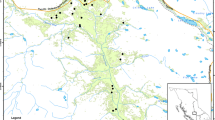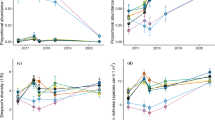Abstract
Two experiments conducted in spring and autumn 1992 examined the effect of mollusc grazing on seedling regeneration from natural grassland seedbanks by creating artificial gaps in plots in a grassland sward. Molluscs were excluded from half the gaps by application of molluscicide. Mollusc grazing in both the spring and autumn experiment significantly reduced seedling recruitment, though the intensity of grazing was greatest in autumn. Recruitment of five species was markedly influenced by molluscicide application. In spring, plots from which molluscs were excluded contained significantly more seedlings of Chenopodium polyspermum and Ranunculus acris. In the autumn, exclusion of molluscs resulted in increased populations of R. acris, Stellaria graminea and Rumex acetosa. Cerastium holosteoides populations were greatest in autumn grazed plots. Other species, notably the grasses Holcus lanatus and Agrostis capillaris and the legume Trifolium repens were unaffected by molluscicide application. Species diversity was significantly decreased by molluscicide application in the autumn. Gap size significantly affected the recruitment of two species. Ranunculus acris populations were significantly higher in small gaps in both spring and summer, while Chenopodium recruitment in the spring was greater in small gaps. Gap size also significantly influenced the risk of mollusc attack on Ranunculus as molluscs appeared to show an aggregative feeding response in the high seedling density small gaps. Selective grazing of vulnerable seedlings by molluscs may influence the eventual relative proportions of the species present and so provide a potent mechanism in shaping community composition in grasslands.
Similar content being viewed by others
References
Aquilera MO, Laurenroth WK (1993) Seedling establishment in adult neighbourhoods — intraspecific constraints in the regeneration of the bunchgrass Bouteloua gracilis. J Ecol 81: 253–261
Barker GM (1989) Slug problems in New Zealand pastoral agriculture. In: Henderson IF (ed) Slugs and snails in world agriculture (Monograph no. 41). British Crop Protection Council, Thornton Heath, pp 59–68
Barker GM, Addison PJ (1992) Pest status of slugs (Stylommatophora: Mollusca) in two New Zealand pastures. Crop Prot 11: 439–442
Barnes HF, Weil JW (1944) I Slugs in gardens; their numbers, activities and distributions. J Anim Ecol 13: 140–175
Bergelson J (1990) Spatial patterning in plants. Opposing effects of herbivory and competition. J Ecol 78: 937–948
Bullock JM, Clear-Hill B, Silvertown J, Sutton M (1995) Gap colonization as source of grassland community change: effects of gap size and grazing on the role and mode of colonization by different species. Oikos 72: 273–282
Byers RA, Bierlein DL (1982) Feeding preferences of three slug species in the laboratory. Melscheimer Entomol Ser 32: 5–11
Clapham AR, Tutin TG, Moore DM (1987) Flora of the British Isles, 3rd edn. Cambridge University Press, Cambridge
Cottam DA (1985) Frequency dependent grazing by slugs and grasshoppers. J Ecol 73: 925–933
Crawley MJ (1983) Herbivory: the dynamics of plant-herbivore interactions. Blackwell, Oxford
Duthoit CMG (1964) Slugs and food preferences. Plant Pathol 13: 73–78
Edwards PJ, Gillman MP (1987) Herbivores and plant succession. In: Gray AJ, Crawley MJ, Edwards PJ (eds). Colonization, succession and stability (Symposia of the British Ecological Society 26). Blackwell, Oxford, pp 295–314
Fenner M (1987) Seedlings. In: Rorison IH, Grime JP, Hunt R, Hendry GAF, Lewis DH (eds) Frontiers of comparative plant ecology (New Phytologist 106 Supplement). Academic Press, London, pp 35–47
Glen DM, Cuerdon R, Butler RC (1991) Impact of the field slug Deroceras reticulatum on establishment of ryegrass and white clover in mixed swards. Ann Appl Biol 119: 155–162
Grime JP, McPherson-Stewart SF, Dearman RS (1968) An investigation of leaf palatability using the snail Cepaea nemoralis. J Ecol 56: 405–420
Hanley ME (1995) The Influence of molluscan herbivory on seedling regeneration in grassland. Ph.D. Thesis, University of Southampton
Hanley ME, Fenner M, Edwards PJ (1995a) An experimental field study of the effects of mollusc grazing on seedling recruitment and survival in grassland. J Ecol 83: 621–627
Hanley ME, Fenner M, Edwards PJ (1995b) The effect of seedling age on the likelihood of herbivory by the slug Deroceras reticulatum. Funct Ecol 9: 754–759
Hassell MP, May RM (1974) Aggregation of predators and insect parasites and its effects on stability. J Anim Ecol 43: 567–594
Hulme PE (1994) Seedling herbivory in grassland: relative impact of vertebrate and invertebrate herbivores. J Ecol 82: 873–880
Kelly D (1989) Demography of short-lived plants in chalk grassland. II. Control of mortality and fecundity. J Ecol 77: 770–784
McConnoughay KDM, Bazzaz FA (1990) Interactions among colonizing annuals: is there an effect of gap size? Ecology 71: 1941–1951
Root RB (1973) Organization of plant-arthropod associations in simple and diverse habitats: The fauna of collards (Brassica oleracea). Ecol Monogr 43: 95–124
Silvertown J, Smith B (1989) Germination and population structure of spear thistle, Cirsium vulgare, in relation to experimentally controlled sheep grazing. Oecologia 81: 369–373
Southwood TRE (1966) Ecological methods. Chapman and Hall, London
Standell C, Clements RO (1994) Influence of grass seed rate, herbicide (bentazone), molluscicide (methiocarb) and insecticide (triaphos) on white clover (Trifolium repens) establishment, herbage yield and sward botanical composition Crop Prot 13: 429–432
Wadham MD, Wynn-Parry D (1981) The silicon content of Oryza sativa L. and its effect on the grazing behaviour of Agriolimax reticulatus Müller. Ann Appl Bot 48: 3990402
Watt TA (1987) Establishment of Senecio jacobaea. L. from seed in grassland and in boxed swards. Weed Res 27: 267–274
Williams RJ (1992) Gap dynamics in subalpine heathland and grassland vegetation in south eastern Australia. J Ecol 80: 343–352
Zar JH (1984) Biostatistical analysis. Prentice-Hall, New Jersey
Author information
Authors and Affiliations
Rights and permissions
About this article
Cite this article
Hanley, M.E., Fenner, M. & Edwards, P.J. The effect of mollusc grazing on seedling recruitment in artificially created grassland gaps. Oecologia 106, 240–246 (1996). https://doi.org/10.1007/BF00328604
Received:
Issue Date:
DOI: https://doi.org/10.1007/BF00328604




